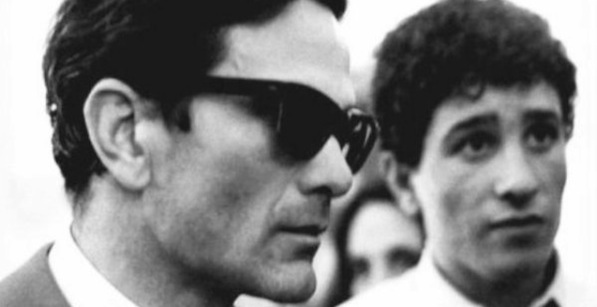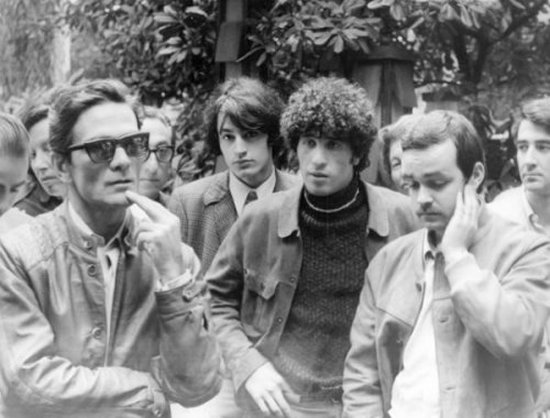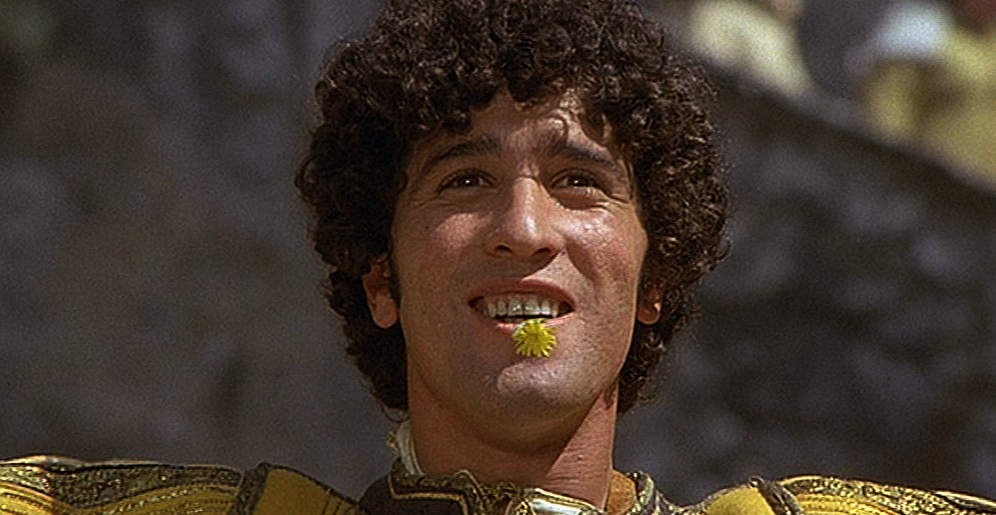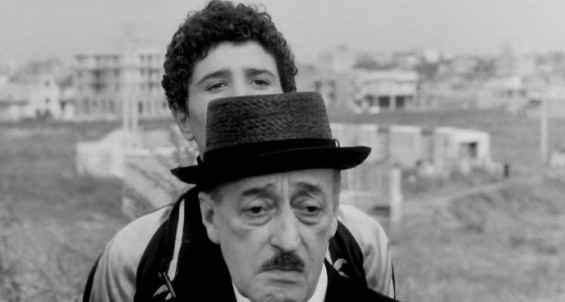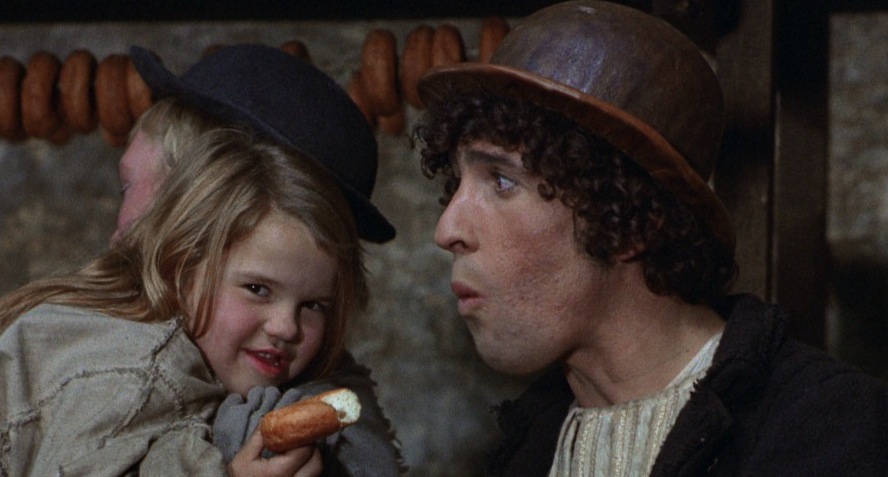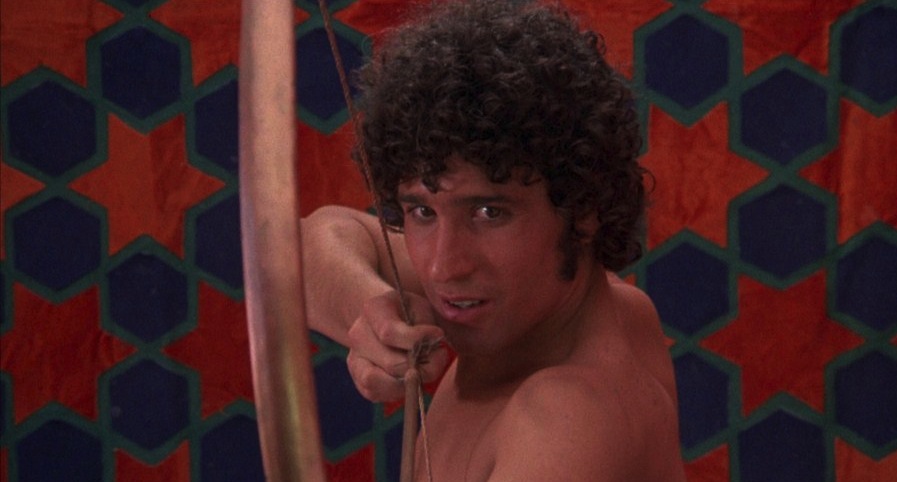‘Everything about him has a magical air…an endless reserve of happiness.’
—Pier Paolo Pasolini on Ninetto Davoli
Luce Cinecittà and Fondo Pier Paolo Pasolini / Cineteca di Bologna brought their major touring retrospective of twenty-two newly remastered 35mm prints of Pier Paolo Pasolini‘s films to the Bay Area through an association with Colpa Cinema, the Italian Cultural Institute of San Francisco, and the Castro Theatre, Roxie Theater and Pacific Film Archive. Part of a larger national tour, the series traveled from New York and Los Angeles, through the Bay Area, and now continues on to Columbus, Washington, Cleveland, Chicago and Toronto. As value added, Luce Cinecittà sent Ninetto Davoli to accompany the series in the Bay Area; he was a charmingly affable ambassador for Pasolini’s oeuvre.
Giovanni “Ninetto” Davoli was born in San Pietro a Maida, Calabria, but moved to Rome when he was just a baby. Always smiling, he was discovered at the age of fourteen by poet, novelist and director Pier Paolo Pasolini who first cast him in a non-speaking role in The Gospel According to Saint Matthew (Il Vangelo secondo Matteo, 1964), and then in a leading role alongside Italy’s celebrated comic actor Totò in Hawks and Sparrows (Uccellacci e uccellini, 1966). Davoli mostly played comical-naïve roles in several more of Pasolini’s films, the last of which was Arabian Nights (Il fiore delle Mille e una Notte, 1974). After Pasolini’s death in 1975, Davoli turned increasingly to television productions. I extend my thanks to Amelia Antonucci of the Italian Cultural Institute of San Francisco for offering the opportunity to sit down to talk to Davoli during his Bay Area visit, and to Antonia Fraser Fujinaga for her translating assistance.
Michael Guillén: Ninetto, it’s such an honor to meet you today, as it’s been a delight to watch your performances in the traveling retrospective of Pier Paolo Pasolini’s films.
Ninetto Davoli: I’m very happy that Pasolini is being brought to the whole world through this traveling retrospective. He was an important person to me in my life. He gave meaning to my life. I’m happy for any chance to speak about him and present his work. It’s really not up to me to say it; but, Pasolini was someone whose time on this Earth has been felt. More than three decades after his death, his books, his writings, his films still have great value. It gladdens my heart that he’s still spoken of and that so many young people will find out more about him and come to value him through this traveling series. I have met many young students who are almost crazy about Pasolini, enthusiastic over learning about him, listening about him. He’s someone who has left an important mark upon the world and it’s interesting to see all that the world has gone through since his death, confirming what he predicted through his writing.
Guillén: Let’s first discuss Pasolini’s eye for discovering talent; his unerring ability to pick faces out of a crowd that he knew could be cinematic.
Ninetto Davoli: That was a characteristic of Pier Paolo’s: to work with simple people and non-professional actors that he would find in the streets. He loved working with non-professionals because he wanted to show in all his films a true and authentic and—in a manner of speaking—a clean reality. He started this practice with Accatone (1961), Mamma Roma (1962) and La Ricotta (1962). He chose authentic faces, though sometimes it’s true that he used important actors; but, mostly for commercial reasons and for reasons of distribution, and to have attention paid to his films.
Guillén: It’s my understanding that you were one of those authentic faces he saw on the streets? That you were among a group of boys who were watching the filming of La Ricotta and his eye singled you out?
Davoli: Yes. The meeting with Pier Paolo Pasolini was pure chance; one of those accidents that occur in life. I was watching the filming of La Ricotta, which was a strange thing for me at the time as a young boy to watch a film being shot. Then, Pasolini was introduced to me and he patted me on the head, caressed my hair, which intimidated me. Later, he offered me a small role in his next film, The Gospel According to Matthew. I didn’t want to be an actor. I was very nervous about it. I was shy and genuinely scared; but, Pier Paolo kept insisting, ‘Please do it.’ I asked him, ‘Do I have to actually speak?’ I was concerned. He reassured me and said, ‘No, no, no. You don’t have to speak. Just make some facial expressions, make some movement’ and so because of that I said, ‘Well, all right then’ and I accepted. I was cast in a small uncredited role as a shepherd playing with a child and, as he promised, all I had to do were a few gestures and movements, and some facial expressions; but, I was still uncertain about it. I have to say, however, that The Gospel According to Matthew has a special place in my heart because I was entering a new world. The emotions that were associated with that will always stay with me.
Guillén: Pasolini’s ability to see iconic qualities in people resulted in an ensemble of countenances that he used again and again to populate his films. This intrigues me how—watching his films as a body of work—the same faces keep appearing, serving an almost archetypal function. Your presence in his films, for example, carries a particular energy. As you and Pasolini became great friends, did he ever express to you his rationalization for this? And what it was that he saw specifically in you, your unique energy, that he wanted to include among his ensemble?
Davoli: As I said before, Pasolini liked street actors because of their natural qualities. In me, he found the naturalness of the world he knew growing up. It wasn’t so much an ‘ability’ as it was that in these faces—including mine—he could see the story he wanted to describe. He could see the story in potential through these faces and he found a reality in them. He preferred imperfection. The young people in his ‘Trilogy of Life’—The Decameron (1971), The Canterbury Tales (1972) and Arabian Nights (1974)—were taken off the streets because he saw the story in them. He saw in their faces the possibility for them to be part of that story. His ability, if anything, was to perceive the right face.
As for what he saw explicity in me, I knew. I collaborated with him to find these actors. He and I would roam the streets together choosing faces and—in the same way, according to the same criteria—he chose me. For example, Franco Merli, ‘Francino’—who played the young lover Nur Ed Din in Arabian Nights—I found working as a gas station attendant. I had gone to the station one morning to fill up my car and Francino recognized me and said, ‘Ninetto, give me an autograph, you’re famous!’ I said to him, ‘Would you like to play a part in one of Pasolini’s films?’ He was, of course, overjoyed. So, later on, I brought Pier Paolo to the gas station to meet Francino. I told him, ‘I have found your face; I have found the person to play Nur Ed Din.’ When Pier Paolo saw him, he said, ‘Oh yes! Absolutely.’ He, too, felt the same thing. We were on the same wavelength, the same frequency; we resonated. I had understood. I had perceived what it was he wanted. This was how I was able to help him choose characters and how I understood why he chose me.
Guillén: Let’s talk about Pasolini’s comic masterpiece Hawks and Sparrows. So here you are, fifteen-sixteen years old, in your first major role with Italy’s most famous comic actor Totò. What can you tell me about Totò and what you learned working with him?
Davoli: Hawks and Sparrows was my first important film and even now—after making nine films with Pasolini—it remains my most beautiful experience. It was a turning point for me. It was incredible. It was implausible. I was wondering, ‘Am I dreaming? How can I be acting with such a big star?’ It was a real drama for me to be thrown deep into this world of making art. I was terrified for about ten to fifteen days; but, after that, I got over it because I realized it wasn’t that hard after all and then I really started to have fun. Totò’s congenial personality resonated with me. I really liked him. It was important working with Totò because after a few days he started teaching me the tricks of the trade and how to be an actor. I learned a lot from him. I had already liked him through his performances. I often went to the cinema to watch his films, and the films of Laurel and Hardy, and Charlie Chaplin, so I was already well-disposed to him. After some time we became almost a pair. We worked well together. We bounced off each other. We bantered. We clicked. We made three films together with Pasolini: Hawks and Sparrows, The Earth As Seen From the Moon (La Terra vista dalla luna, 1966) and What Are the Clouds? (Che cosa sono le nuvole?, 1967). Totò was a great, seasoned master of his craft when I was just starting out. He didn’t show off. He wasn’t conceited. He was a simple, unassuming person and Pasolini saw this. He saw that Totò had a face and a being, a personality, an inner simplicity, and—although he was a big star—deep down he was, and always remained, just an ordinary person like me.
Guillén: One of the reasons I enjoyed Hawks and Sparrows so much was because I felt it demonstrated that you were, in effect, Pasolini’s actor fetiche. I sensed that you expressed his joy and his capacity for fun. Can you speak to Pasolini’s sense of humor? In conjunction with that, since you and Pasolini were such good friends and you were often with him—I’ve seen footage of you sitting beside him when he was being interviewed on difficult political and religious subjects—how much of that serious content impacted your own intelligence?
Davoli: Pasolini was not a cheerful person. Quite the opposite. He was, for instance, very shy. When he met me, it was like meeting himself as a younger person, as a boy. He saw in me the joy that he would have liked to have had, but hadn’t had. He saw the cheerful boy that he would have wanted to be but now could no longer be. He suffered a lot as a child. He was the son of a school teacher and a colonel in the Army. He had a conflicted relationship with his father Carlo and this traumatized him; it stayed with him. His father had a commanding air. He was authoritarian, strict and austere. It was from his mother Susanna that he received tenderness, understanding and compassion. She was all that he loved. He adored her his entire life. In meeting me, he encountered the joy of living.
When he went to conferences and spoke with intellectuals, he used a high intellectual register. He used big words and convoluted expressions and I, being very young, couldn’t understand what he was saying, although later on when I grew up and spent more time witnessing this side of him, I learned and came to understand. He used this high register of intellectualism when he was interacting with intellectuals, while with the exact same intelligence—the same weight in a sense—he was simple with simple people. As I said, with the same weight, the same equilibrium, he could harmonize with simple people, like me. He could adapt with great purpose to these two different ways of being.
When we were seeking actors together, it was all joy. It was fun, cheerful and lighthearted. When he was at conferences or spending time with his intellectual friends like the poet Alberto Moravia, then of course he used this heavier style; but, somehow, he didn’t manifest the disparity, the break, between these two worlds. It’s not that Pasolini didn’t love the intellectual world, but his preference was for the more natural human world. When we were together, it was as if a weight had fallen off him. He lightened up. He was more free and relaxed. He was looser and more cheerful. When he was with the intellectuals, he was much more restrained and less carefree. When we were looking for actors, or playing football, or wandering around, he was very natural. He enjoyed it. That was what he preferred; but, his intellectual weight, the power of his intellect, likewise existed at the same time. Therefore, it inevitably brought him into contact with this heavier world, which was not his preference. It wasn’t that it was hard for him, perhaps it was tiring, but he was an intelligent man. It wasn’t as if he had to compete with them, as if they were more clever than him, it wasn’t that at all. It’s just that he was happier when he could be carefree in his other, simpler world.
Guillén: Not only did he circle in simple and intellectual worlds, but also spectacular ones, as with his collaboration with Maria Callas in the film Medea (1969). Can you speak to that?
Davolil: Although I made nine films with Pasolini, unfortunately Medea was not one of them because—while it was being filmed—I was undergoing my mandatory military service in Italy, so I couldn’t take part; but, I did get to meet Maria Callas. I didn’t know who she was but Pasolini told me she was a famous singer. I didn’t quite understand what he meant by that because singers, to me, were pop stars. At the time when they were filming in Rome, Pasolini told me to go to the Grand Hotel where Callas was staying to keep her company. So I said, ‘Okay….’
I drove up to the hotel in my spectacular new sports car, which I’d just bought because I had finally made some money. I was all excited about it. The doorman at the hotel was dressed in a uniform and he looked like a policeman. He said, ‘Good evening. Would you like to give me the keys to your car?’ I said, ‘What?! It’s my car. I’m not giving you the keys to my car. I’ll park it myself.’ I was afraid he was going to steal it. After I parked it, I went up to Maria Callas’s room. I didn’t quite know what to say to her because I didn’t really know much about her so I said, ‘Maria, you are a good singer aren’t you? How do you have such a voice? How do you do it?’ She said, ‘I have this voice because of years of study, constant exercise, and exhausting practice every day.’ So I asked, ‘How do you practice?’ She said, ‘Put your hands here on my back’ and she let out a high note. I felt her prodigious muscles and said, ‘Maria, you’ve got some incredible muscles there!’ She said, ‘Yes, those are the fruits of years of effort that I was telling you about.’
I started to get bored because I was very young and—though she was a famous star—I didn’t know much about her. So I asked her, ‘What should we do? What do you want to do?’ and she said, ‘Whatever you want.’ I thought, ‘Oh dear.’ I said, ‘Should we go around Rome, perhaps? Should we go for a little drive?’ She said, ‘That’s a wonderful idea. How splendid.’ I thought, ‘Oh dear. I have to take her around Rome.’ So off we went in my wonderful new vroooom vroooom sports car racing around Rome like nobody’s business and I took her to a dodgy bar; the type of bar in a seedy part of town that Pasolini often portrayed in his films because he knew them so well. So we walked in and I said to the owner, ‘Look who I brought. I brought Maria Callas!’ He said, ‘Yeah, right, you brought Maria Callas.’ No one could imagine that I would take Maria Callas to a dodgy bar! He came around and saw that, indeed, it was Maria Callas and stepped up to meet her.
I tell you this story because it’s an example of how bizarre my experience was with Maria Callas. I was bowled over by this extraordinary person. She was exceptional. She had an incredible internal strength. Just as I was bowled over by her, and the owner of the bar was bowled over by her, so was Pasolini. We were all overwhelmed by her. From that night was born something of a flirtation, a love story, between her and Pasolini.
Guillén: Once you completed your military service, you then participated in Pasolini’s ‘Trilogy of Life’, first as Andreuccio of Perugia in The Decameron in 1971, then as the rascal Perkin in The Canterbury Tales in 1972, and finally as Aziz in Arabian Nights in 1974. Let’s discuss those films.
Davoli: It’s a bit hard to understand now, but the importance of The Decameron was that Pasolini uncovered the naked bodies of men and women for the first time in an artistic film. When I say ‘naked’, I mean naked in its poetic sense of showing the love between two people. When the film came out, people weren’t yet used to that kind of thing and they were shocked. There were lawsuits and the film was considered by some to be mere pornography. The Decameron definitely caused a great hullabaloo. Despite the controversy, however, the film was a colossal success and was Italy’s highest-grossing film for close to a year. Furthermore, after it came out, it was copied by other film directors who made The Indian Decameron, The African Decameron, Decameron II, Decameron III, spawning a whole series of Decameron films. So, again, at that time people were struck by that kind of cinema. It’s an excellent film, even though it doesn’t necessarily have the same effect now as it did back then. People are used to this kind of nudity now.
The Canterbury Tales was hard work for me because it was all done in English. All the actors were English themselves, generally found on the outskirts of London. The thing is, though, neither I nor Pier Paolo spoke any English. When we went around looking for potential actors, this was how we did it: we would roam the streets of London looking for people who might look right and—if Pier Paolo would come across someone who he thought might work—he would send me to use my broken English to approach them with some boring excuse like asking for directions. As the person would start to give directions, Pier Paolo would stand some distance away, maybe five meters, and would use his hands to frame shots to see if this person would look right through the camera. If he thought they might work, he would then approach and the two of us would try in our broken English to offer the person a part in the film. But if he didn’t think they would work, he would signal to me unobtrusively and I’d say, ‘Thank you very much’ and walk away.
The film was shot mainly in London and Canterbury and what was particularly tiring for me was my role, my character. I don’t want to say that it was an imitation of Charlie Chaplin but it was, in a sense, an homage to him. To enable me to do that, I had to watch all of Chaplin’s films to understand, internalize and capture Chaplin’s style in order to be able to make an appropriate homage. Charlie Chaplin’s daughter Josephine was an actress in The Canterbury Tales and—after the film came out—a really wonderful thing happened. Charlie Chaplin said to his daughter, ‘If you see that boy, tell him he did a good job.’ To receive a compliment from Charlie Chaplin was something incredibly special for me. It will stay with me forever.
During one of our many trips together, every evening before we went to sleep Pier Paolo would tell me stories from The Thousand and One Nights, and at the end of the trip we analyzed the stories and decided which ones to display in the film Arabian Nights. He wrote the script with the help of Dacia Maraini. Then we went scouting for locations in Yemen, Africa, Thailand, and so on, to find small villages that would fit the themes we had imagined. After that, we considered the characters. As we’ve discussed, one of Pasolini’s abilities was to find realistic characters who looked authentic. Again, he chose locals, non-actors, so that for The Decameron they were all Neopolitan, for The Canterbury Tales they were all English, and for Arabian Nights they were African and Middle Eastern people. This entire process of collaborating on the scenes, scouting for locations, and finding the actors would take six, seven, to eight months before we actually started to shoot the films themselves.
Guillén: I’m sure you’re aware that Abel Ferrara is planning a biopic of Pasolini’s life starring Willem Dafoe in the lead role? Are you involved as a consultant on that project? Or will you be a cameo in that film?
Davoli: Yes, I am aware of that. Willem Dafoe phoned me in Italy to suggest collaborating on this film and I discovered that he would be playing Pasolini. I said to Abel Ferrara, ‘I’ll do it; but, first, I want to know what you’re going to say? What you’re going to tell about Pier Paolo?’ He said that he wanted to talk about his last days and his final tragedy and I said, ‘If it’s only that, if that’s all you want to talk about, then I won’t accept. I won’t do it.’ He said, ‘But, no, it takes his death as the starting point and then goes back to tell his whole story.’ So I said, ‘Write the script first and, if I like it, we can collaborate.’ That’s the point where we are now. I’m waiting for the script. If I like it, I’ll become involved. If not, I won’t.
Guillén: My understanding is that Ferrara wants to approach Pasolini’s death by way of a Rashomon construct. Since Pasolini’s death is, to this day, shrouded in mystery and controversy, it’s my undestanding that Ferrara is intending to propose a multi-perspective view on Pasolini’s death. For example, one of the theories that I’ve become aware of that truly shocked me was a supposition put forth by Giuseppe Zigaina in the documentary Pasolini and Death: A Purely Intellectual Thriller (2005) that Pasolini orchestrated his own death. Do you have an opinion on that? What do you feel actually happened? And I apologize in advance if this is too personal an inquiry; but, I’m genuinely curious.
Davoli: Of course it makes me very sad to speak of this and I don’t like to talk about this because the night before he died we were together and the next day I was called to identify his corpse. Obviously, this is painful for me to discuss. From what I understood from Ferrara, his film was not intended to talk about Pasolini and his story but just about his final tragedy; not him, just his gruesome death. I told him, ‘If all you want to talk about is his horrifying death, not him and his story, then I won’t do it. But if you do want to talk about his entire story—including inevitably his gruesome death as part of the story but not the total focus—then I will do it.’
As for this idea that Pasolini orchestrated his own death, I think it’s nonsense. From my perspective, the way that I see it, almost certainly Pier Paolo stumbled on a bad situation. He had an unlucky night, which ended badly. It was an accident. It wasn’t intended. It wasn’t planned. These later rumors that his death was political or staged—all these elaborate stories that circulated later on—I think they’re all nonsense. They’re all just rumors.
The Pasolini exhibition travels to UC Berkeley’s Pacific Film Archive from September 20 to October 30, to Houston’s Museum of Fine Arts from September 27 to October 27 (shipping films back and forth), to Washington DC’s National Gallery from November 2 to November 30, to Washington’s American Film Institute right after, to Columbus, Ohio from January 9 to February 25, 2014 and later to Toronto (dates to be confirmed).

